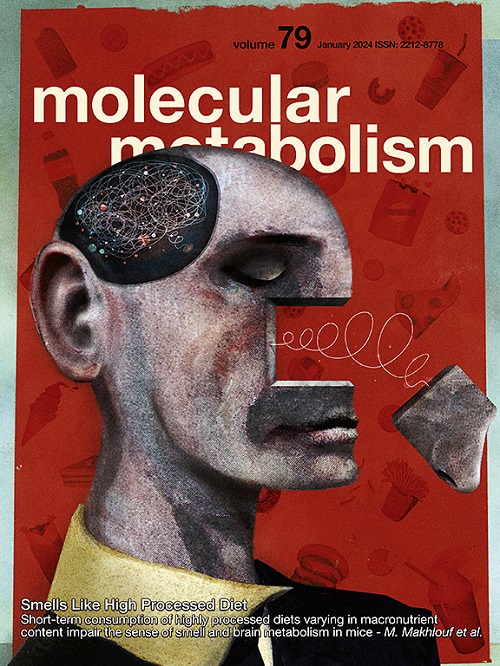VGluT3 BNST neurons transmit GABA and restrict sucrose consumption
IF 6.6
2区 医学
Q1 ENDOCRINOLOGY & METABOLISM
引用次数: 0
Abstract
Objective
The bed nucleus of the stria terminalis (BNST) is involved in feeding, reward, aversion, and anxiety-like behavior. We identify BNST neurons defined by the expression of vesicular glutamate transporter 3, VGluT3.
Methods
A combination of in situ hybridization, tract tracing, ex vivo whole-cell electrophysiology, in vivo recording, optogenetic, and behavioral approaches were used.
Results
VGluT3 neurons were localized to anteromedial BNST, were molecularly distinct from accumbal VGluT3 neurons, and co-express vesicular GABA transporter (VGaT). BNST VGluT3 neurons projected to arcuate nucleus (ARC) and paraventricular nucleus of the hypothalamus (PVN), regions critical for feeding and homeostatic regulation. Most single BNST VGluT3 neurons projected to either PVN or ARC and a subset projected to both. BNST VGluT3 neurons functionally transmit GABA to both ARC and PVN, with rare glutamate co-transmission to ARC. In vivo, VGluT3 BNST neurons showed greater neuronal activity in response to sucrose consumption while sated compared with fasted. When fasted, optogenetic stimulation of BNST VGluT3 neurons decreased sucrose consumption using several stimulation conditions but not when stimulation occurred prior to sucrose access, suggesting that BNST VGluT3 activation concurrent with consumption in the fasted state reduces feeding. BNST VGluT3 activation had no effect on anxiety-like behavior in several paradigms (novelty-suppressed feeding, open field, and elevated zero maze). BNST VGluT3 activation also did not result in real-time place preference or aversion.
Conclusions
We interpret these data such that VGluT3 BNST neurons represent a unique cellular population within the BNST that provides inhibitory input to hypothalamic regions to decrease sucrose consumption.
VGluT3 BNST神经元传递GABA并限制蔗糖的消耗。
终纹床核(BNST)参与进食、奖励、厌恶和焦虑样行为。我们鉴定了由谷氨酸囊泡转运体3 (VGluT3)表达定义的BNST神经元。VGluT3神经元定位于前内侧脑脊神经st,在分子上与伏隔区VGluT3神经元不同,并共同表达水泡状GABA转运蛋白(VGaT)。在下丘脑弓状核(ARC)和室旁核(PVN)中发现了BNST VGluT3突触素的表达,这两个区域对进食和稳态调节至关重要。逆行跟踪显示,大多数BNST VGluT3神经元投射到PVN或ARC,还有一部分神经元同时投射到PVN和ARC。当这些神经元共同表达VGluT3和VGaT时,离体全细胞电生理实验显示,它们同时向ARC和PVN传递GABA,而向ARC共传递谷氨酸是罕见的。VGluT3 BNST神经元的体内记录显示,与禁食相比,在饱食状态下,VGluT3 BNST神经元对蔗糖消耗的反应更强烈。当禁食时,光遗传刺激BNST VGluT3神经元减少了蔗糖的消耗,但在获得蔗糖之前的刺激没有减少,这表明BNST VGluT3在禁食状态下与消耗同时激活会减少摄食。BNST VGluT3的激活对几个范式(新颖性抑制进食、开放场地和高零迷宫)的焦虑样行为没有影响。BNST VGluT3的激活也不会导致实时位置偏好或厌恶。我们对这些数据的解释是,VGluT3 BNST神经元代表了BNST内一个独特的细胞群,它向下丘脑区域提供抑制性输入,以减少蔗糖消耗。
本文章由计算机程序翻译,如有差异,请以英文原文为准。
求助全文
约1分钟内获得全文
求助全文
来源期刊

Molecular Metabolism
ENDOCRINOLOGY & METABOLISM-
CiteScore
14.50
自引率
2.50%
发文量
219
审稿时长
43 days
期刊介绍:
Molecular Metabolism is a leading journal dedicated to sharing groundbreaking discoveries in the field of energy homeostasis and the underlying factors of metabolic disorders. These disorders include obesity, diabetes, cardiovascular disease, and cancer. Our journal focuses on publishing research driven by hypotheses and conducted to the highest standards, aiming to provide a mechanistic understanding of energy homeostasis-related behavior, physiology, and dysfunction.
We promote interdisciplinary science, covering a broad range of approaches from molecules to humans throughout the lifespan. Our goal is to contribute to transformative research in metabolism, which has the potential to revolutionize the field. By enabling progress in the prognosis, prevention, and ultimately the cure of metabolic disorders and their long-term complications, our journal seeks to better the future of health and well-being.
 求助内容:
求助内容: 应助结果提醒方式:
应助结果提醒方式:


